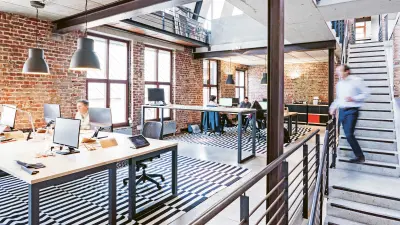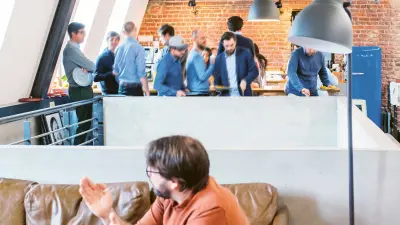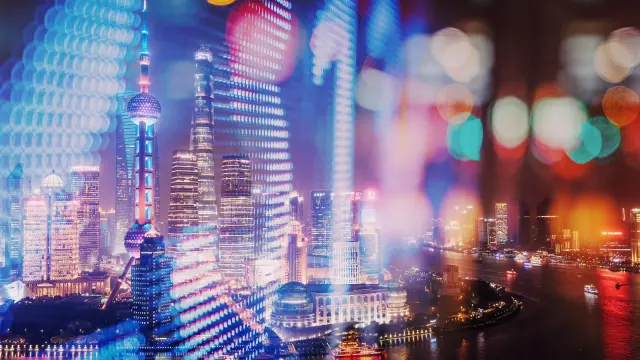How new concepts are transforming our work

New Work – just another buzzword from the startup scene or the future of workplaces? The opinions are divided. But the coronavirus pandemic has made it impossible to ignore new ways of collaborating. In any case, this trend has already advanced far beyond teleworking and video calls.
New Work puts people and their needs at center stage
What exactly is “New Work”? Wikipedia defines it as follows: “The new way of working of today’s society in the global and digital age.” Among other things, it involves new, more flexible approaches to performing and organizing (office-type) work. Teleworking, also known as telecommuting, is an example. It is frequently mentioned in connection with Work 4.0, an overarching conceptual framework for the future of work that is catching on in Germany and elsewhere. People are gaining the ability to work from anywhere at any time, and the entire economy is being progressively networked. These trends pose both opportunities and challenges for rethinking work in terms of flexibility, structures, and work environments.
Breaking out of old molds – Fabian Mottl, a brand communications manager at Steelcase, a company that has specialized in creating innovative work environments, has this to say: “While conventional corporate structures inhibit individuals’ creativity by rigidly defining working conditions and hierarchical structures, New Work strives to promote self-determined activity by workers.” He interprets it, more than anything else, as an attitude that puts people and their needs first.
Creativity driven by encounters

New Work is a comprehensive philosophy whose ideas can also be applied to designing office spaces. “Work environments crucially define employees’ work ethic and wellbeing,” says Dr. Marion Weissenberger-Eibl. She holds a professorship for innovation and technology management at the Karlsruhe Institute of Technology (KIT) and also heads the Fraunhofer Institute for Systems and Innovation Research ISI. She defines New Work as a shift away from rigid structures and toward greater flexibility, better quality of life, and more communication. “One of the ideas underpinning the New Work movement is that random encounters are conducive to creativity.” According to Weissenberger-Eibl, the role of architecture is to facilitate these meetings.
New Work is a comprehensive philosophy whose ideas can also be applied to designing office spaces. “Work environments crucially define employees’ work ethic and wellbeing,” says Dr. Marion Weissenberger-Eibl. She holds a professorship for innovation and technology management at the Karlsruhe Institute of Technology (KIT) and also heads the Fraunhofer Institute for Systems and Innovation Research ISI. She defines New Work as a shift away from rigid structures and toward greater flexibility, better quality of life, and more communication. “One of the ideas underpinning the New Work movement is that random encounters are conducive to creativity.” According to Weissenberger-Eibl, the role of architecture is to facilitate these meetings.
Simon Wu, the founder and managing director of iDA Workplace, a Shanghai-based company devoted to innovative workplace design, recommends dividing up work environments according to needs, not people. Because people, thanks to modern technologies, can work wherever they like. Wu distinguishes three different working modes: focused work, knowledge transmission, and traveling. “Keeping these types in mind, you can choose your work environment depending on your needs: do you want to be alone, hold a workshop, or brainstorm in a group?” He stresses that this is key for boosting efficiency and creativity. Over the long term, it lets a company produce better results. Wu is confident that in the future, the focus will be on the group, not individuals. Areas for meeting and collaborating are therefore paramount.
Sometimes small changes are enough, however: “Being in an area designed to disrupt routines or simply looking out of a window can be enough to spark new ideas,” explains Fabian Mottl. Whiteboards or writable walls, for example, support visualization and sharing of ideas. But that by itself isn’t enough, he stresses. There’s also a need for tailored spatial concepts.
Buildings as personal assistants

Digital networking also plays a major role in New Work. Simon Wu also describes his vision of a smart booking system that suggests the ideal space for a given worker based on the context – i.e., what he or she wants to work on, how many people will participate, and what is needed in the way of furnishings and equipment. Smart building technology would then also adjust parameters like air quality and humidity and temperature. All this makes working far more comfortable and healthy.
Martin Höttecke, who holds a professorship at the Münster University of Applied Sciences and is a prominent expert on smart homes and smart buildings, can also definitely imagine, for example, employees networking their smartphones with the company parking building. “Just imagine: the carpark knows that you’re on your way in your electric car and automatically guides you to a space that’s equipped with a charging station. This saves you unnecessary stress at the start of your day.” Or else the building knows exactly who enters it and calls an elevator if they need one. “There are no limits to the imagination here. At the end of the day, it’s about building automation that helps people,” says Höttecke.
“New Work is possible anywhere we can take advantage of digitalization.”
People need people
Videoconferencing is now an everyday affair. Has New Work already become the new normal? “I don’t think we’ve accomplished this shift yet,” says Weissenberger-Eibl. “But now is the perfect time for companies to think about which tools and processes they would like to keep and where there’s room for improvement.” It’s also important to keep in mind that people are social animals. Digital solutions can support communication among them – but not replace it.
In general, it can be said that New Work is possible anywhere, in any industry, and in companies of all sizes – after all, every environment can be designed to be “people-friendlier”, according to smart building specialist Höttecke. For example, a large hospital in Westphalia is now testing a system for locating things: “It’s a great help for nursing staff if they no longer have to constantly hunt for things they need, like laundry carts.” Trackers can provide assistance here. “New Work is possible anywhere we can take advantage of digitalization.”

Work environments can make the difference for job hunters

New Work will also play a major role in recruiting new talent. Weissenberger-Eibl cites large U.S. tech companies that long ago began coming up with new incentives to attract talented people. Google, for example, created a huge “campus” in Mountain View, California that included free laundry rooms, volleyball courts, and swimming pools. According to Weissenberger-Eibl, this approach involves purposefully blending living and working environments to increase the likelihood that employees will stay on. It can also be a stress factor, however; not every employee can deal with a situation in which work and private life are hard to separate. Teleworking approaches also mean that they are constantly available, requiring them to exercise considerable discipline in organizing their time. “Some people experience this as stressful. We’ve had to take this seriously and come up with good solutions.”
Saving time while reducing CO₂ emissions
New digital ways of working will also positively impact the environment. “When it’s no longer necessary for all employees to commute to the office each morning, traffic jams will be a thing of the past,” says Höttecke. Besides saving time and reducing stress levels, CO₂ emissions will also drop. Plus, it will be possible to use available office space more efficiently. Smart building automation plays a major role in this: it can make workplaces not only more comfortable, but also more energy-efficient and sustainable.
Whether it’s about architecture, sustainability or employer branding, “New Work has so many exciting aspects – and everything is interconnected,” says Höttecke. And everything is in motion, because the future of work is only just beginning.

